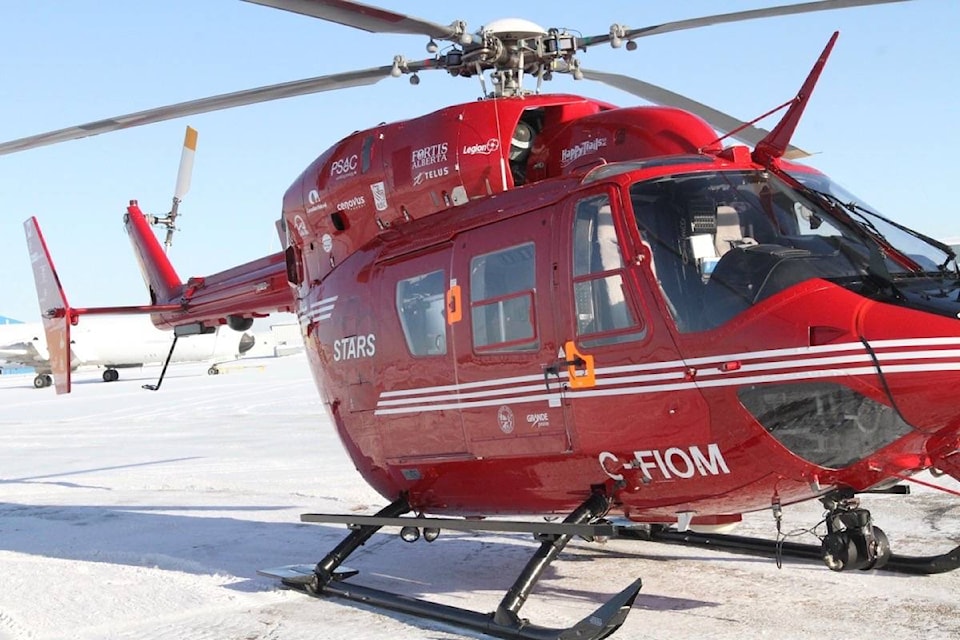This story comes as a follow up to our Critical Condition series that investigated gaps in pre-hospital care in rural B.C. We will have more stories on the future of care as reaction and policy discussions emerge.
A new not-for-profit society is hoping to fill some service gaps in the emergency medical services field in British Columbia.
According to the organization’s website, Technical Evacuation Advanced Aero Medical (TEAAM) is a group of paramedics and physicians dedicated to providing advanced life support (ALS) medical care in remote, difficult to access locations.
Using hoist and long line (HETS) equipped helicopters, TEAAM can access patients in remote industrial sites, forestry operations, First Nations communities, and marine environments. Once on scene, TEAAM will provide cutting-edge, advanced medical care to allow for quick and safe extrication and transport of patients.
TEAAM president Miles Randell has 21 years experience as an ambulance paramedic and 27 years experience with search and rescue organizations. The organization will operate in collaboration with Blackcomb Helicopters out of Squamish.
“Over the years, I have noticed there is a gap in pre-hospital care coverage in British Columbia,” explained Randell. “It is handled very well in other places such as Switzerland and New Zealand.”
“If you were to suffer a workplace injury or an injury in a remote place in Australia, you would dial the local service and you would get a dedicated helicopter with doctors and paramedics that are trained in accessing patients in rugged or technical terrain through a hoist-capable helicopter.”
“We realized the gap was there and that the current services that exist were not able to combine that kind of [accessing patient] capability with the medical capability. So we decided to start the organization.”
About two weeks after they decided to form the organization, the founders came across BC Forest Safety Ombudsman Roger Harris’s report criticizing serious gaps in access to helicopter emergency transport for rural B.C. and calling on the government and British Columbia Emergency Health Services (BCEHS) to make changes.
“It basically laid out exactly what we were building,” said Randell.
TEAAM hopes to operate on a public-private partnership or P3 model.
“We have had donations from industry, we have had donations from charities and we are working with government to try to secure some funding,” added Randell.
“Currently we are not exactly rolling in money — we are going to launch on a bit of a wing and a prayer.”
TEAAM will have its first base in Squamish but hopes to eventually expand to five bases.
“Based out of Squamish we can reach the west coast of Vancouver Island and the Tofino area as well as Kamloops, Sun Peaks and up to the Cariboo Chilcotin.”
When looking for future base locations the organization will consider geographical suitability, call volume and industry base to allow for donations to support operations for that area.
“The amount of support from industry has been huge,” said Randell. “Everyone agrees the concept is absolutely needed — but we haven’t had a ton of people lining up to donate in the industry yet. Our hope is once we get rolling, people will quickly see the need.”
Randell said their service will also provide financial benefits to corporations, WorkSafe and the health-care system.
“There are a number of studies out there that show the financial benefits of being able to provide advanced life support medical care rapidly on scene. Providing those rapid interventions and minimizing injury and illness and being able to transport to the appropriate hospital … the local hospital is not always the most appropriate.”
“We are not intending to take over search and rescue work or ambulance work, our intention is to fill a gap where paramedical retrieval care doesn’t exist.”
TEAAM doesn’t intend to “reinvent the wheel” but is being modelled after other successful programs.
“We have travelled to Switzerland and looked at forest services over there,” explained Randell. “We have had two Australians come over and teach us how they do it — the model in Australia is very impressive.
“We are definitely leaning on those that are well established and that are experts in the field. If we are going to do this we want to do it right for sure.”
While the TEAAM funding model is similar to Alberta’s emergency helicopter organization STARS, the operational model is different.
“STARS is doing helicopter EMS work, what we are doing is retrieval medicine,” explained Randell.
“For example, if we pulled up to a remote logging site where an air ambulance couldn’t land, and we found a patient was pinned in a logging truck — we can hoist down right onto the logging truck, we have extrication capabilities so we could take the patient out of that entrapment and provide medical care and then hoist them up into the aircraft.”
Because the organization does not have a full budget yet, they will operate on an on-call basis at first but will be able to fly within 15 minutes of a call. TEAAM missions will be staffed with advanced life support providers — Advanced Care Paramedics, physicians or a combination of the two. Current staff includes intensive care physicians, emergency room physicians, anesthesiologists, and pediatric anesthesiologists.
All of the stories in the Critical Condition series can be found at castlegarnews.com/tag/critical-condition-investigation
